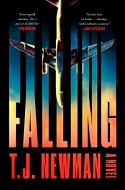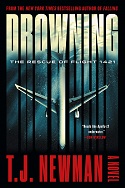 Synopsis:
Synopsis:
An airline pilot suffers a fatal widowmaker heart attack at 35,000 feet. And the unthinkable happens. The commercial airliner carrying two hundred and ninety-five lives crashes into the Clover Hill nuclear power plant in the small town of Waketa, Minnesota. It immediately becomes ground zero for a catastrophic national crisis with global implications.
The International Nuclear Event Scale tracks and categorizes nuclear disasters. It has seven levels. Level 7 is a Major Accident and only two are on record: Fukushima and Chernobyl. There has never been a Level 8 incident. Until now.
Ordinary people — power plant employees, firefighters, teachers, families, neighbors, and friends — are thrust into an extraordinary situation and face the ultimate test of their lives. It will take the combined courage, ingenuity, and determination of a brave few to determine the fate not only of their community and loved ones . . . but humanity at large.
Review:

Bestselling author T.J. Newman’s Cinderella-esque success story is already legendary. After receiving rejections from forty-one agents, she sent an unsolicited copy of the manuscript of her first novel, Falling, to the founder of The Story Factory, Shane Salerno (whose other clients include Don Winslow, Adrian McKinty, and Meg Gardiner). Fatefully, his assistant called in sick, so he opened his own mail on the day Newman’s submission was delivered. “The rest is history,” as the cliché goes. “What got my attention was how cocky [her handwritten] note was, the false bravado,” Salerno says. It remains the only unsolicited manuscript Salerno has ever accepted. When published, the book flew straight to the top of bestseller lists and inspired a bidding war for the rights between major Hollywood studios and producers. Now, Newman is drafting the screenplay.
The same thing happened with Newman’s second book, Drowning: The Rescue of Flight 1421. It was also an instant bestseller and spawned another bidding war in which Nicole Kidman and Steve Spielberg, in addition to other renowned artists, competed.
After the staggering success of Falling, Newman was intent on making her sophomore novel “bigger. In every aspect, it had to be bigger. Bigger heart, bigger action, bigger stakes.” It was. In Drowning: The Rescue of Flight 1421, Newman trapped passengers on a flight from Honolulu to San Francisco inside a plane teetering on the edge of an underwater cliff two hundred feet down in the Pacific Ocean, situated in the narrow channel between the small, largely uninhabited Hawaiian islands of Moloka’i and Lana’i where the trade winds can be fierce. As with the terrorist plot at the center of Falling, Newman tackled a predicament not addressed in the rigorous training provided to pilots and flight attendants. Yet she managed to make both storylines not just believable, but heart-stoppingly tense and heart-tuggingly emotional.
When Drowning: The Rescue of Flight 1421 was released, Newman reported she was working on her third novel with the goal of amping up the story’s dramatic tension even further. Readers may have thought it unimaginable, but, remarkably, she has attained her goal.
Newman had the idea for Worst Case Scenario while researching her first novel by querying pilots not just about all aspects of their job, but also their fears. They often told her they worried about their aircraft getting caught in power lines, making erroneous decisions, freezing and not being able to make decisions and, of course, not returning home to their families after a flight. But Newman says one pilot’s answer “stopped me in my tracks.” She wasn’t sure if he was serious and initially scoffed when he told her, “My greatest fear is a commercial airliner crashing into a nuclear power plant.” Newman believed it an impossibility due to structural standards and security measures in place “in a post-9/11 world.” She naively thought “all nuclear power plants were safe from attack.” But the pilot disavowed her of that idea, saying, “That’s exactly what they want you to think.”
Newman circled back to the idea for her third novel. At the outset, she knew virtually nothing about nuclear power plants but, luckily, discovered that because of industry transparency, the needed information is readily available, which was not the case when she was working to ensure that the plots of her first two novels were plausible. Newman describes her books as “plot focused” and once she completed her research, the genesis of Worst Case Scenario was a complete outline totaling around sixty pages setting forth the action.
It isn’t about the individual. It’s about the whole. The collective. The greater good. But it’s a paradox. Because what is the whole without the individual? If we do not care for the life of one person, how do the lives of millions have meaning?
Worst Case Scenario is a departure for Newman in that the focus of the book is not on how her protagonists will rescue the airliner’s passengers and crew. But the story does open with a crisis on board. As the plane is flying over Minnesota, the pilot suffers a fatal widowmaker heart attack and the 757 goes into free fall. At United Grace Church in the little town of Waketa, fifty-five miles south of Minneapolis, widower Steve Tostig, Clover Hill’s on-site Fire Chief, is attending the mid-day Good Friday service. The walls and floor begin to rattle just as something flies over the church, and a loud boom shakes the entire structure. Steve immediately springs into action as Dr. Joss Vance notices the lights in her kitchen flickering and instantly knows what is about to happen. The power goes out. As she grabs her work go-bag containing a satellite phone, full-body hazmat suit, masks, gloves, rubber boots, and a bottle of pills, she washes down the radioprotective potassium iodide with the coffee she had been drinking at her kitchen table and races out the door, en route to Clover Hill. The alert on her phone confirms what she already knows. There has been an incident at the plant. Potentially, a Level 7 incident. “When you work in nuclear power, you never fully forget what it is you do. How dangerous it is, how horrific the potential could be. You always, always respect the potential.” So Joss has “always known a day like this was not a matter of if but when.” In fact, it was that knowledge that brought her home to Waketa and her job as the regional representative of the Nuclear Emergency Support Team. After earning a PhD in nuclear engineering at MIT, Joss worked on policy at the Nuclear Regulatory Commission in Washington, D.C. where she grew tired of “being dismissed as an alarmist.”
The large plane breaks apart, strewing debris across a vast area. Just as a van is crossing the bridge over the Mississippi River, carrying a family to an Easter celebration, one of the wings — ten times larger than the van and carrying hundreds of thousands of gallons of jet fuel — lands directly in the van’s path. The rear of the van is left dangling thirty feet above the icy water as a massive fire erupts. Five-year-old Connor, who was riding in the van his father was driving, is conscious and still strapped into his car seat.
Newman employs her straight-forward, unembellished storytelling style to describe the confusion and chaos that ensues after the crash. In the control room, Plant Manager Ethan Rosen and his staff don’t immediately know what has happened – explosion, earthquake, terrorist attack, equipment failure? – because they work in a windowless room in the building that houses one of three reactors. Clover Hill is in the process of being decommissioned, but it takes years. So only one reactor has been taken offline. The other two were online and generating power when the plane crashed. With alarms sounding, staff frantically begin assessing the status of the plant and soon learn that pieces of the aircraft are scattered across the Clover Hill campus. Gradually, they realize what they are dealing with . . . and must figure out how to address the damage the plant has sustained, a situation no one has ever faced before. They discover that the power line to the plant has been severed so the plant is running on backup diesel generators, and there is extensive structural damage throughout, including to the pool where spent fuel rods are warehoused. It is leaking. If the water level becomes low enough and the rods are exposed, the building in which they are stored will explode. The plant began operating in 1973, so the amount of nuclear waste stored there would feed a fire of a “magnitude mankind has yet to conceive of a way to put out. It would burn forever.” In other words, it could be the world’s first Level 8, “extinction-level event.”
Newman notes that “it’s very easy to get your characters into trouble. It’s a lot harder to get them out of trouble.” And the trouble her characters face in Worst Case Scenario could be exponentially more far-reaching than the crises depicted in her first two books. She “reverse engineers” her stories. So once she decided that the plane would crash into the plant, she had to figure out the challenges her characters would face and how they would handle them. She set the tale in the fictional small town, rather than a larger metropolitan area, to illustrate “a real nightmare worst case scenario for the country.” Other regions, like California (where only the Diablo Canyon plant remains operational, and three others have been fully decommissioned), have more resources and safeguards available. And by situating Clover Hill at the top of the Mississippi River, the catastrophe has the potential to destroy “the heart of the country,” rendering uninhabitable a large swath of land bisecting the United States.
Once again, Newman has created a cast of empathetic characters navigating a crisis that demands they be their best selves. Ethan and Steve, in leadership roles, gather input and make hard decisions, while Joss serves as the liaison to America’s youngest-ever President, who is safely ensconced five stories down in the White House’s Deep Underground Command Center with his advisors. Newman alternates the action between what is transpiring at the plant and, to a lesser degree, how the people of Wateka band together, relying on information broadcast by a retired plant engineer from an underground bunker on the plant’s campus. His forty-seven-year career included a role in the plant’s construction and his insight proves invaluable.
A second major narrative thread focuses on a group of heroic first responders who refuse to abandon little Conner, even though they have no idea how to safely extract him from the van. Newman includes a gut-wrenching exploration of the allocation of scarce resources and the options available in such circumstances, noting that they are “undermanned, under-resourced, out of ideas, and out of time trying to save one individual person.” Must the needs of many be prioritized over the peril faced by one? “It’s about saving the fate of humanity. But what is that, if not the life of one individual?” she observes.
Throughout Worst Case Scenario, Newman deftly illustrates her characters’ palpable terror and the responsibility they feel to each other, as well as the countless Americans who will be impacted in myriad ways if their survival mission fails. The characters are fully developed and believable – not surprisingly, most rise to the occasion, but some take longer than others. Most importantly, Newman compels readers to care about her characters and their futures. The story would not succeed sans that emotional connection and she is gratified when readers identify with and cheer for her characters because she cares deeply about their welfare as she brings them to life, going through “boxes and boxes of Kleenex” when she writes. Her compassion is evident on every page, alongside her readily understandable and terrifying explanations of precisely what is at stake. Newman says that “the absolute heart and essence of my stories, is everyday people in an extraordinary circumstance rising to meet the moment. I deeply believe in the everyday hero in all of us, and that ordinary people only need the opportunity to be the heroes that they actually are.”
To dismiss Newman’s latest tautly crafted story as far-fetched or implausible would be a mistake. She says Worst Case Scenario was more difficult to write than her first two books because once she began researching the subject matter, she “realized that the premise of the book is completely plausible, and . . . this research scared the hell out of me.” Still, she does not consider the tale an indictment of the nuclear energy industry. “If I have an agenda with my books, it is to entertain. Full stop.”
Newman has penned another horrifyingly realistic and deeply unsettling thriller. It is fast-paced, tense, and riveting. It is also moving, replete with heartbreaking losses and disappointment, as well as valor, personal sacrifice, and triumph. She explores familial and community relationships, challenging readers to contemplate how they would react in a similar situation. It is certain to be yet another bestseller . . . and leave readers pondering just what she will come up with next.





Comments are closed.